Health Benefits Of Curd From Different Animals
By Vd. Rangaprasad Bhat.
Table of Contents
Introduction
Benefits of curds from different animals and curd recipes with spices areexplained in Ayurveda Mahodhadhi, a text book by Sushena, of 14th century.
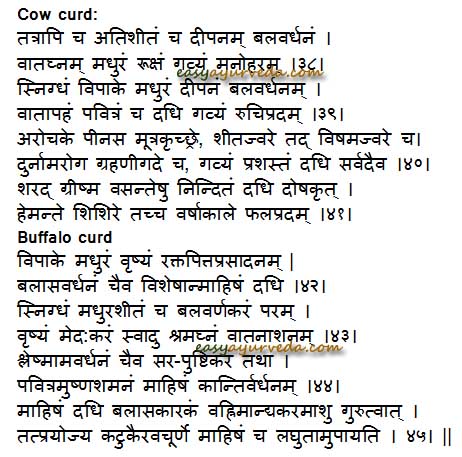
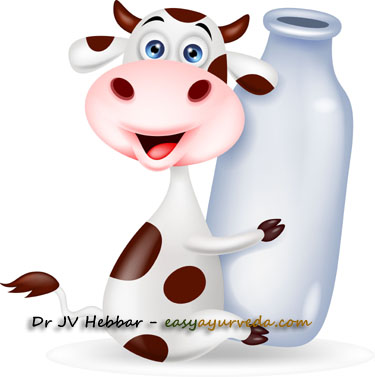
Cow curd
Atisheeta – very coolant
Deepana – improves digestion strength
Balavardhana – improves strength and immunity
Vataghna – Balances Vata, useful in neurological disorders such as paralysis, hemiplegia, neuropathy etc
Madhura – sweet
Snigdha – unctuous, oily
Useful in
Arochaka – anorexia, lack of interest in food
Peenasa – rhinitis
Mutrakrichra – dysuria, difficulty to pass urine
Sheetajwara – fever
Vishamajwara – Recurrent fever
Read related: What is curds? How to make curds?
Season based usage of curd and its effect
The cow’s curd is not advisable in Autumn, Summer and Spring seasons, since it will result in vitiation of Doshas.
Where as in winter, and in rainy seasons it is beneficial.
Buffalo curd
Buffalo milk: Mahisha Dadhi:
Madhura – sweet
Vrushya – aphrodisiac
Increases Kapha Dosha
Snigdha – unctuous, oily
Sheeta – cold
Balakara – improves strength and immunity
Varnakara – improves skin coimplexion
Vrushya – aphrodisiac
Medakara – increases fat
Vatanashana – Balances Vata Dosha
Shleshmavardhana – increases Kapha
Amavardhana – increases indigestion, weakens digestion
Sara – laxative, promotes movement of liquids in channels
Pushtikara – rich in nutrition
Read related: Cow milk And Buffalo Milk – A Comparison
Useful in
Raktapitta – bleeding disorders like nasal bleeding, Ulcerative colitis and menorrhagia
Shrama – tiredness, fatigue
When mixed with Trikatu (Ginger, pepper and long pepper), it causes lightness of the body. |42-45.
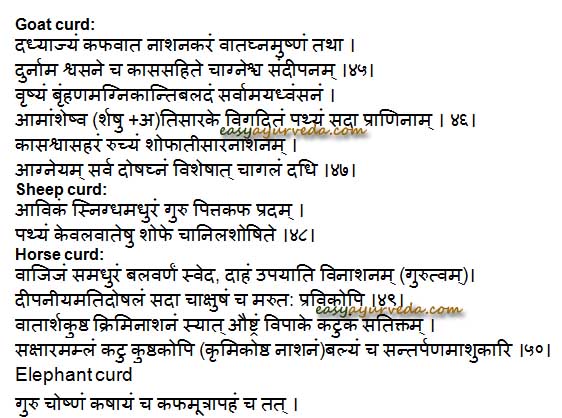
Goat curd
Balances Kapha and Vata Dosha
Ushna – hot
Deepana – improves digestion strength
Brumhana – improves nourishment
Vrushya – aphrodisiac
Kantida – improves skin lustre
Balada – improves immunity and strength
Ruchya – improves taste, useful in anorexia
Pathya (conducive as food)
suitable to be used in almost all the Ama conditions like Ama arsha, ama Atisara
Shopha nāśanam (reduces the edema).
Balances all the three Doshas.
Useful in
Shwasa – asthma, respiratory disorders involving difficulty in breathing
Kasa – cold, cough
Shopha – oedema,
Atisara – diarrhea, dysentery
Durnāma (haemorrhoids); |45 – 47|
Read related: Curds benefits, Side Effects As Per Ayurveda

Sheep curd
Sheep curd – Avi Dadhi:
Snigdha – unctuous, oily
Madhura – sweet
Guru – heavy to digest
Increases Pitta and Kapha
Useful in Vata increase and when the person has become lean and lost weight due to increase of Vata Dosha
Useful in Shopha – inflammation
Read related: Curds recipe of Amla – Ayurvedic home remedy
Horse curd
Horse Curd benefits:
Madhura – sweet
Balakara – improves strength and immunity
Varnya – Improves skin tone and complexion
Reduces sweating and burning sensation
Chakshushya – improves vision, good for eyes, useful in eye disorders
Increases Doshas, especially Vata Dosha
Read related: Curd consumption at night? Can You Take Curd At Night?
Camel curd
Camel curd benefits:
Balances Vata Dosha
Katu – pungent, spicy
Tikta – bitter
Sakshara – slightly alkaline
Amla – sour
Balya – improves strength and immunity
Santarapana – nourishing, rich in nutrition.
Useful in
Arsha – Hemorrhoids
Kushta – skin diseases
Krimi – intestinal worms
Read related: How to make buttermilk, types: Ayurvedic method
Elephant curd
kaṣāyaṃ (astringent).
guru(heavy for digestion);
uṣṇaṃ (hot in potency).
kapha – mūtrāpahaṃ (alleviates kapha and urine related ailments).
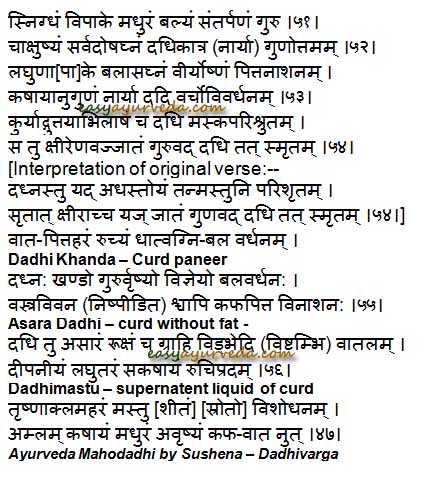
Human milk curd
Snigdha – unctuous, oily
Madhura – sweet
slightly Astringent
Balya – improves strength and immunity
Santarpana – nourisihing, rich in nutrition, coolant
Guru – heavy
Chakshushya – useful in improving eye sight
Decreases Kapha and Pitta Dosha
Varcovivardhanam (promotes bulkiness of malas);
rucyaṃ (improves taste);
dhātvagni-bala vardhanam (enhances the dhātvagni and physical strength)
Dadhi Khanda
Dadhi Khanda – Cheese curd or paneer –
Guru – heavy
Vrushya – aphrodisiac
Balavardhana – improves strength and immunity
Balances Kapha and Pitta Dosha.
Asara Dadhi
Asara Dadhi -Curd without fat essence:
Rooksha – dry
Grahi – absorbent, bowel binding, useful in IBS, diarrhoea
Vishtambhi – producer of wind in abdomen, causes bloating
Vid bedhi – Breaks down feces into smaller particles
Vatala – Increases Vata Dosha
Deepana – improves digestion strength
Laghu – light to digest
Kashaya – astringent
Ruchiprada – Ruchya – improves taste, useful in anorexia
One may understand Asara Dadhi to be colloidal,non-settling precipitate –(which is a precursor stage to the syneresis process where in the agglomerated dense mass of gel contracts and squeezes out the whey water to complete the process of curdling).
Mastu
मस्तु whey water-
Sheeta – cold
Srotovishodhana – Clears and cleanses body channels
Amla – sour
Kashaya – astringent
Madhura – sweet
Avrushya – unaphrodisiac
Balances Kapha and Vata Dosha
Useful in
Trushna – Excessive thirst
Klama – fatigue
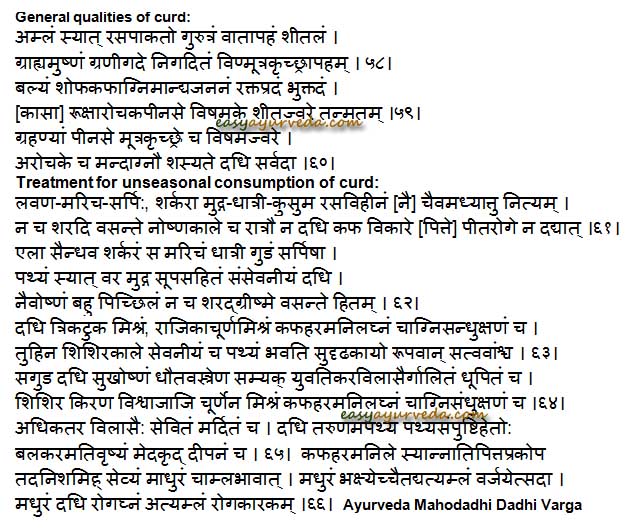
Curd – General qualities
Amla – sour
Guru – heavy
Balances Vata Dosha
Grahi – absorbent, bowel binding, useful in IBS, diarrhoea
Balya – improves strength and immunity
Increases Kapha Dosha
Can cause inflammation
Can cause Agnimandya – low digestion strength
Useful in
Grahani – Malabsorption syndrome, Irritable Bowel Syndrome
Mutrakrichra – dysuria, difficulty to pass urine
Kasa – cold, cough
Aruchi – Anorexia, lack of interest in food
Peenasa – rhinitis
Mutrakrichra – dysuria, difficulty to pass urine
Remedies for non-seasonal curd consumption
Remedies for nonseasonal consumption of curd:
A Few recipes of dadhi in combination with herbs for the purpose partaking it daily in the seasons usually advised to avoid it are explained in the following verses.
If you are consuming curd on daily basis, it needs to be consumed mixed with any of below mentioned substances.
Salt, pepper, ghee,
sugar, green dhal,
Indian gooseberry, honey (kusuma rasa)
Avoid taking plain curd (without mixing anything during autumn, spring and summer seasons.
Avoid taking plain curd during night, without mixing anything.
Avoid regular consumption of curd in Kapha and Pitta disorders. 61|
If one desires to take curd on daily basis, then it needs to be mixed with Triphala or along with green gram soup.
Curd can be taken daily by mixing cardamom, rok salt, sugar candy, black pepper, Indian gooseberry, jaggery, ghee.
Where in too, care be taken that the soup mixed mixture of dadhi is neither hot, nor too sticky.
This recipe is designed to make it suitable for partaking in the sharad and grīṣma and vasanta seasons. |62|
In Mild winter, to improve digestion strength and to balance Kapha and Vata Dosha,
Curd should be taken mixed with
Trikatu (Pepper, long pepper and ginger) or
mixed with mustard seeds. |63|
During winter, to balance Kapha and Vata Dosha, jaggery is mixed with curd. Later the mixture is strained with a wet and clean cloth to filter the mixture and fumigation be done
To the filtered mixture add ginger and cumin powder. |64|
By consuming this preparation, sexual power is enhanced.
Freshly prepared curd is Apathya – not conducive to health.
But if they are added with pepper etc, substances, even the fresh curd improves strength, it is good for lipids, and improves digestion strength. |65|
Sour curd should be avoided:
Fresh curd with sweet taste Balances Kapha and Vata.
Sour curd increases Pitta Dosha.
Hence sweet curd should be consumed and sour curd should be avoided. |66|










4 comments
Shwetha
Very useful. Hereafter will not throw whey water into Wish basin…
Dr PMK
what is your view on moringa powder which has become very popular?
Dr J V Hebbar MD(Ayu)Author
It has its own uses, but most of the claims are over-hyped.
I have written about moringa benefits here
https://www.easyayurveda.com/2012/12/06/moringa-benefits-medicinal-usage-complete-ayurveda-details/
harinderpal singh
good information…..